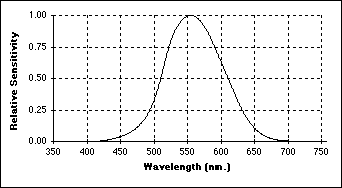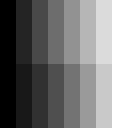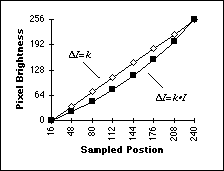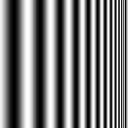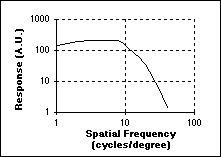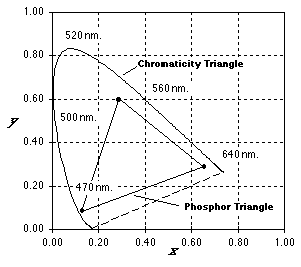Perception |
||||||||||||||||||
Many
image processing applications are intended to produce images that are to
be viewed by human observers (as opposed to, say, automated industrial
inspection.) It is therefore important to understand the characteristics
and limitations of the human visual system--to understand the
"receiver" of the 2D signals. At the outset it is important to
realize that 1) the human visual system is not well understood, 2) no
objective measure exists for judging the quality of an image that
corresponds to human assessment of image quality, and, 3) the
"typical" human observer does not exist. Nevertheless,
research in perceptual psychology has provided some important insights
into the visual system. See, for example, Stockham .Brightness Sensitivity
There
are several ways to describe the sensitivity of the human visual system.
To begin, let us assume that a homogeneous region in an image has an
intensity as a function of wavelength (color) given by I(
Wavelength sensitivity
The perceived intensity as a
function of
Figure 10:
Spectral Sensitivity of the "typical" human observer Stimulus sensitivity
If the constant intensity (brightness) Io is allowed to vary then, to a good approximation, the visual response, R, is proportional to the logarithm of the intensity. This is known as the Weber-Fechner law:
The
implications of this are easy to illustrate. Equal perceived
steps in brightness,
A
horizontal line through the top portion of Figure 11a shows a linear
increase in objective brightness (Figure 11b) but a logarithmic increase
in subjective brightness. A horizontal line through the bottom portion
of Figure 11a shows an exponential increase in objective brightness
(Figure 11b) but a linear increase in subjective brightness.
Figure
11a Figure 11b (top) Brightness step
The
Mach band effect is visible in Figure 11a. Although
the physical brightness is constant across each vertical stripe, the
human observer perceives an "undershoot" and
"overshoot" in brightness at what is physically a step edge.
Thus, just before the step, we see a slight decrease in brightness
compared to the true physical value. After the step we see a slight
overshoot in brightness compared to the true physical value. The total
effect is one of increased, local, perceived contrast at a step
edge in brightness. Spatial Frequency Sensitivity
If the constant intensity (brightness) Io is replaced by a sinusoidal grating with increasing spatial frequency (Figure 12a), it is possible to determine the spatial frequency sensitivity. The result is shown in Figure 12b .
To
translate these data into common terms, consider an "ideal"
computer monitor at a viewing distance of 50 cm. The spatial frequency
that will give maximum response is at 10 cycles per degree. (See Figure
12b.) The one degree at 50 cm translates to 50 tan(1deg.)
= 0.87 cm on the computer screen. Thus the spatial frequency of maximum
response fmax = 10 cycles/0.87 cm = 11.46 cycles/cm at
this viewing distance. Translating this into a general formula gives:
where
d = viewing distance measured in cm. Color Sensitivity
|
|
Source
|
x |
y |
|
Fluorescent lamp 4800 deg.K |
0.35 |
0.37 |
|
Sun 6000 deg.K |
0.32 |
0.33 |
|
Red Phosphor (europium yttrium vanadate) |
0.68 |
0.32 |
|
Green Phosphor (zinc cadmium sulfide) |
0.28 |
0.60 |
|
Blue Phosphor (zinc sulfide) |
0.15 |
0.07 |
Table 6: Chromaticity coordinates for standard sources.
The
description of color on the basis of chromaticity coordinates not only
permits an analysis of color but provides a synthesis technique as well.
Using a mixture of two color sources, it is possible to generate any of
the colors along the line connecting their respective chromaticity
coordinates. Since we cannot have a negative number of photons, this
means the mixing coefficients must be positive. Using three color
sources such as the red, green, and blue phosphors on CRT monitors leads
to the set of colors defined by the interior of the
"phosphor triangle" shown in Figure 14.
The
formulas for converting from the tristimulus values (X,Y,Z)
to the well-known CRT colors (R,G,B) and back are
given by:

and

As
long as the position of a desired color (X,Y,Z) is
inside the phosphor triangle in Figure 14, the values of R, G,
and B as computed by eq. will be positive and can therefore be
used to drive a CRT monitor.
It
is incorrect to assume that a small displacement anywhere in the
chromaticity diagram (Figure 14) will produce a proportionally small
change in the perceived color. An empirically-derived
chromaticity space where this property is approximated is the (u',v')
space:
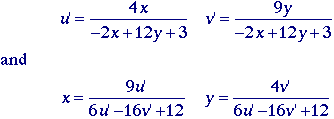
Small
changes almost anywhere in the (u',v') chromaticity space
produce equally small changes in the perceived colors.
 Optical
Illusions
Optical
Illusions
The description of the human visual system presented above is couched in standard engineering terms. This could lead one to conclude that there is sufficient knowledge of the human visual system to permit modeling the visual system with standard system analysis techniques. Two simple examples of optical illusions, shown in Figure 15, illustrate that this system approach would be a gross oversimplification. Such models should only be used with extreme care.
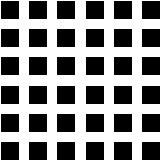

Figure 15:
Optical Illusions
The
left illusion induces the illusion of gray values in the eye that the
brain "knows" does not exist. Further, there is a sense of
dynamic change in the image due, in part, to the saccadic movements of
the eye. The right illusion, Kanizsa's triangle, shows enhanced contrast
and false contours neither of which can be explained by the
system-oriented aspects of visual perception described above.
